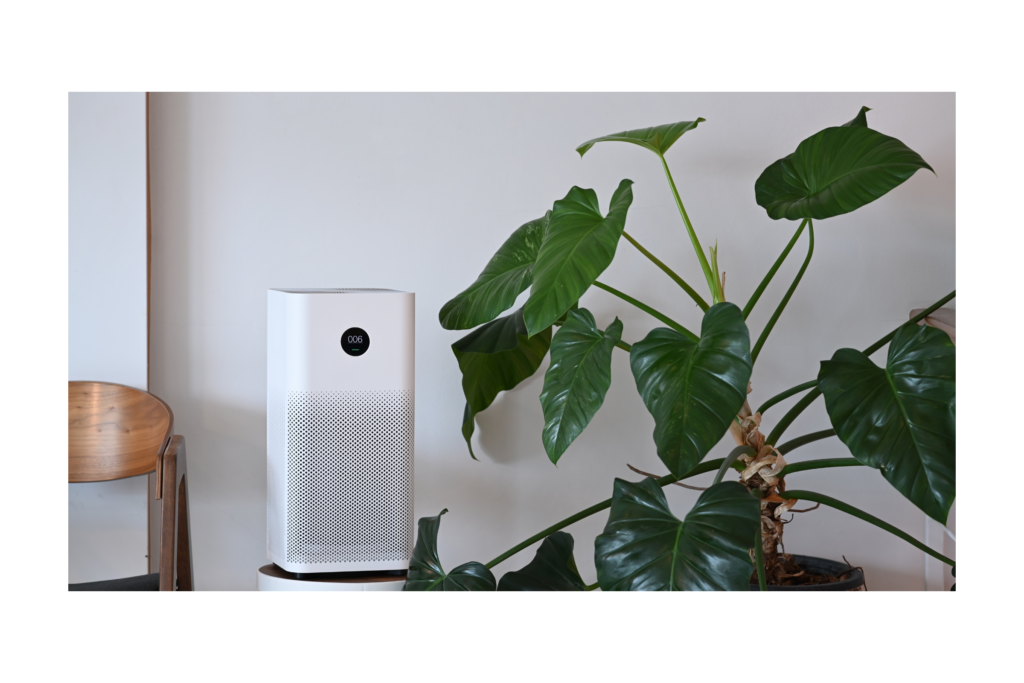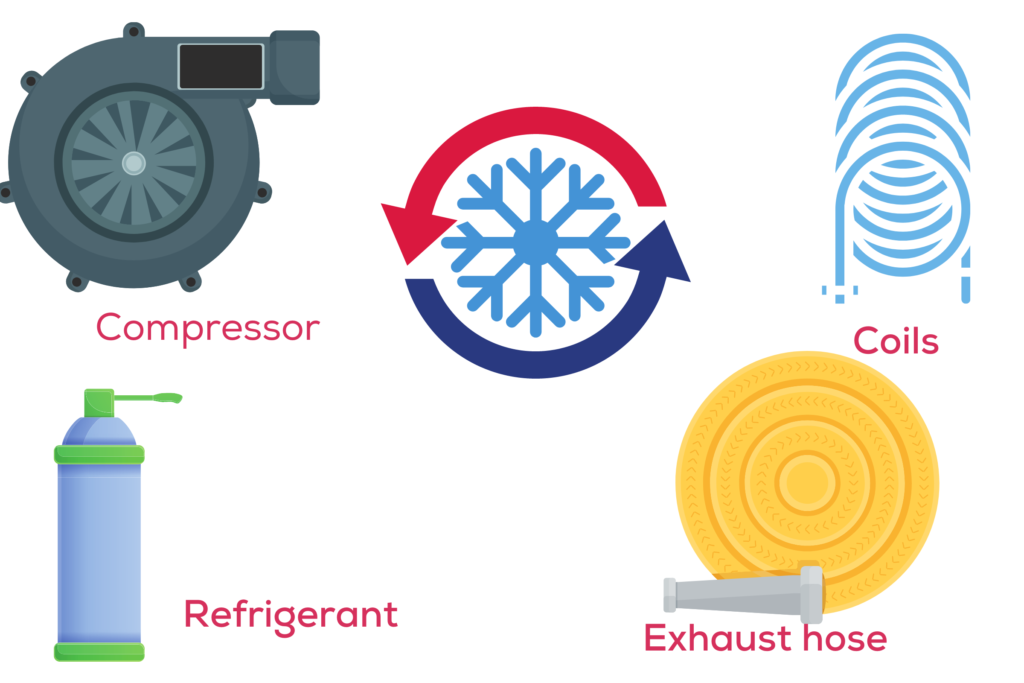Can You Lay a Portable Air Conditioner on Its Side Without Damage?
Summer brings sunshine and a rise in temperatures. Portable air conditioner units are a smart way to cool a room while saving on energy costs, but sometimes they don’t quite fit the decor aesthetic we’re trying to achieve. If your room has space issues, can you lay a portable air conditioner on its side without damage?
You shouldn’t lay a portable AC on its side when it is in operation. Doing so can affect the compressor leading to damage or permanent failure. If you need to transport the air conditioner, it is acceptable to lay it on its side for short periods of time. However, it should remain upright before turning it on.
Read on to learn more about operating portable air conditioners and storage and transport tips!

Can you lay a portable air conditioner on its side?
Our master bedroom gets hot afternoon sun. Even with a fan and the central air on, it doesn’t reach prime sleep coolness during the summer. Enter a portable a/c unit! This has been a lifesaver during our hot, humid Southern summers. Our unit can cool down a room in minutes.
A portable air conditioner is designed to work while in an upright position. If you lay it on its sides or back, you will inhibit its ability to cool properly and possibly damage the compressor or other internal parts.
To prevent mechanical fatigue and keep your unit in tip-top shape, always run it in the upright position.
How do portable air conditioners work?
To understand the dangers of operating a portable a/c unit on its side, it’s necessary to learn how these portable units operate.
Portable air conditioners work by taking in hot air and extracting it outside. Refrigerant runs through the machine’s condenser coils, cooling down the hot air. A compressor compresses the liquid refrigerant turning it into a gas. An exhaust hose to the outside of the house expels the hot air, humidity, and condensation.

What Are the Effects of Laying a Portable Ac on Its Sides?
Each part of a portable a/c unit has a specific job to do. To keep them operating as they were intended, the unit needs to be standing.
Laying a portable air conditioner on its side can damage the compressor, cause oil spills, crimp the exhaust hose, or cause condensation leaks. All of these effects can cause permanent damage to the unit or damage to your home.
Side-laying a/c units can cause the following problems:
- Damaged compressor
- Oil spills/impeded flow
- Crimped exhaust hose
- Condensation leaks
Damaged compressor
The compressor is a crucial part of the air conditioner, which enables it to function properly. It puts pressure on the refrigerant, which helps do away with humidity in the air, all while cooling your house in the process.
Your a/c can have either a rotary or scroll compressor. When you lay the portable a/c on its side, the compressor that moves and vibrates as it runs won’t do this easily. This movable part will struggle to spin and, in the end, have a mechanical failure.
Oil spills/impeded flow
The compressor is lubricated by oil. Good lubrication reduces friction, and this helps to eliminate excess heat build-up that can put a strain on the unit’s shaft and bearings. When the a/c unit is on its side, the oil will not flow through the compressor correctly. This can result in ineffective operation, damage, and unsightly oil spills on your floors.
Crimped exhaust hose
The exhaust hose serves an important purpose. It provides a vehicle for the hot air, humidity, and condensation to go from inside your home to the outside. When you lay the unit on its side, you are increasing the risk of a damaged or crimped hose. This can impede the airflow deeming your unit worthless.
Condensation leaks
When the a/c is on, it tries to cool down the temperature, and condensation occurs. This happens when the warm air gets into contact with the evaporator coils. The temperature will reduce, and liquid will be produced in the process. This liquid condensation will then go to the a/c’s condensation pan.
If you have a model with an external drip pan, turning the unit on its side can cause the water to leak out onto your floor instead of being collected in the pan.
Note: Portable air conditioner units are either fully evaporative or partially evaporative. Both styles allow moisture to exit out through the exhaust hose automatically. If you lay the a/c on the side, this self-evaporative technology can be adversely affected.
Is it possible to store a portable a/c while lying on its side?
Cooler weather calls for heat instead of a/c. If you choose to store your portable air conditioner, can you lay it on its side when storage space is limited?
Laying the air conditioner on its side while storing will cause oil not to reach the compressor. If you must store it this way, you want to avoid operating the unit immediately after getting it out of storage. The unit should remain upright for at least 24 hours before operating.
The harm isn’t in the storing itself but in the fact that damage can occur due to poor lubrication. Allowing upright time will help redistribute oil to the compressor reducing the chances of damage.
The longer it lays on its side, the longer you should allow it to remain upright before operating. Most owner’s manuals will address this concern and give you specific guidance for your model.
Storage tips for a portable air conditioning unit
Storing your unit properly in the off-season will make it last longer and reduce your maintenance expenses.
Store your portable air conditioning unit away from direct sunlight and extremely low temperatures. Disconnect it from power, remove the exhaust hose and any drain knobs, drain off any water, and clean the filters. Following these steps will prepare it for the next season.
- Disconnect the power cord wrap and store it at the back of the AC.
- Remove the vent hose and wind it up carefully.
- Drain off any water in the condensation pan. Also, remove the drain knob to prevent rust.
- Detach the filters and clean them.
- Store in a cupboard or closet away from direct sunlight and extremely low temperatures.
Can you lay a portable a/c on its side when transporting it?
What happens if you move and the unit can’t travel upright?
You can lay a portable air conditioner unit on its side while transporting. When you arrive at your location, set the unit upright. A good rule of thumb is to let it stand upright for the same duration it laid on its side before operating.

How to extend the life of your portable air conditioner
Portable air conditioner units are an investment. They can cost $400 and up.
To extend the life of your portable air conditioner, look for leakages, lubricate as needed, and keep the unit clean.
Look for leakages
If the refrigerant leaks, it can damage your machine. A unit that suddenly struggles to cool can be a symptom of refrigerant leakage. Troubleshooting early will allow you to fix the problem before damage occurs.
Lubricate as needed
You should also lubricate the portable a/c to prevent friction and heat from affecting the unit’s performance. Your manual will tell you how to add oil. Doing so regularly will reduce the need to repair and replace worn-out parts.
Keep it clean
Dust happens. Don’t let it clog up your portable a/c unit. Dust and debris can coat the coils and clog up the compressor and exhaust hose. Use a vacuum or compressed air to clear away debris.
Summary of “Can you lay a portable air conditioner on its side without damage?”
Laying a portable AC on its side is not advisable as it will destroy the compressor due to a lack of lubrication. Oil won’t be able to flow correctly, and this can cause undue friction. The exhaust hose can also become damaged or crimped. The condensation pan will also be incapable of collecting water, and this could result in floor damage.
If you must store or transport your unit on its side, allow sufficient time upright before operating.
FAQS
What is the difference between a portable air conditioner and a window air conditioner?
Window air conditioners are designed to fit into a window opening, while portable air conditioners are not. Window air conditioners must be vented to the outside, while portable air conditioners can be vented either to the outside or to a room adjacent to the one in which they are cooling. Portable air conditioners are usually less expensive than window air conditioners.
How many BTUs does a portable air conditioner have?
A portable air conditioner typically has a heat output of between 5,000 and 10,000 BTUs. This means that the appliance can cool a room that is between 150 and 300 square feet in size.
How do I lay a portable air conditioner on its side?
The process of laying a portable air conditioner on its side generally includes lifting the unit onto a surface that is slightly elevated, such as a table, and tilting it so that the front of the machine is facing downward. This will help to ensure that the condensation created by the cooling process can properly escape from the machine.
What size of a portable air conditioner can I lay on its side?
The size of a portable air conditioner that can be laid on its side is typically around 12-18 inches in height. This allows the unit to be easily placed in tight spaces or moved from room to room as needed. While all portable air conditioners are designed to be movable, some are taller and may not be able to be laid on their sides. It is important to check the dimensions of the specific model you are interested in before making a purchase.
Let Us Know How We’re Doing!
Did this expertly prepared resource answer your question?
Do you have another question about home maintenance, home improvement projects, home appliance repair, or something else?
Get more information, send in questions and keep the discussion going by contacting the I’ll Just Fix It Myself company customer service team at at 1-800-928-1490 or Email us at [email protected]
